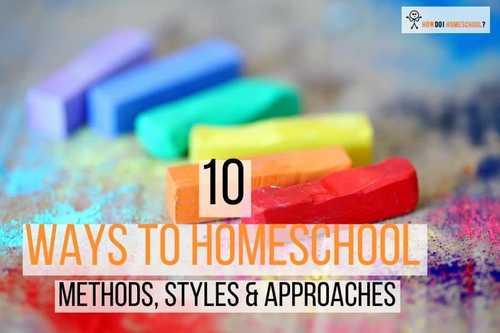10 Homeschool Methods, Styles & Approaches: Which is Yours? - How Do I Homeschool
Curated from: howdoihomeschool.com
1
Explore the World's Best Ideas
Join today and uncover 100+ curated journeys from 50+ topics. Unlock access to our mobile app with extensive features.
Choosing the best method
People have different educational preferences, which means home education will look different from family to family.
The main homeschooling methods are:
- The classical method
- Charlotte Mason method
- Montessori approach
- Waldorf/Steiner approach
- Unschooling style
- Unit studies
- Traditional method (shool-at-home)
- Multiple intelligences theory
- Eclectic approach
8
34 reads
The Classical Homeschooling Method
This method of education capitalizes on the three stages a person's brain thinks.
- Stage 1: Young children tend to think about things using concrete ideas and forms.
- Stage 2: As children get older, they begin to integrate their thoughts and synthesize their learning.
- Stage 3: In the teenage years, children begin to think deeply and abstractly.
The Classical Method uses the Trivium teach according to the stage the brain is at naturally. The Trivium consists of:
- The Grammar Stage: Children focus on the tools of learning. They learn how to write and use grammar correctly.
- The Logic Stage: Children deepen their knowledge. Debating is introduced as a way to synthesize what they've learned.
- The Rhetoric Stage: Children become independent thinkers. They learn about persuasive and loving ways to express their opinions.
7
13 reads
The Charlotte Mason (CM) Homeschooling Method
The British educator, Charlotte Mason, founded the CM approach.
- CM advocated short lessons, nature walks, and field trips.
- Apart from reading, writing, and arithmetic, CM believed other learning should be done by exposing children to knowledge through nature and 'living books'.
- Mason advocated testing children in a non-confrontational way without the stress of feeling like they are being examined. This is done through narration.
6
12 reads
The Montessori Homeschooling Method
The Montessori method is based on self-directed activity, hands-on learning, and collaborative play. The classroom and the teacher offer age-appropriate activities while the children make creative choices in their education.
CM principles include:
- Respect for the child
- The sensitive periods
- The absorbent mind
- Mixed-age groupings
- The prepared environment
- The curriculum areas
- Montessori materials
- The role of the teacher
6
11 reads
The Steiner/Waldorf Homeschooling Method
Rudolf Steiner's education theory - known as Waldorf education - advocates hands-on, creative play and the use of a monthly learning theme called the Main lesson. Waldorf education is based on anthroposophy.
Some elements in the Waldorf/Steiner approach:
- Avoidance of technology in the early years.
- Deliberate mentoring relationship
- Using natural materials for play
- Doing tasks as a team
- Encouraging students to learn hands-on skills they'll use in life.
6
10 reads
The Unschooling Style
The term 'unschooling' was coined by John Holt, a schoolteacher who became frustrated with the school system because of its rigidity. Holt advocated that children should have as much freedom as the parents can bear to learn unrestricted by unnecessary rules, procedure, and busywork.
With the unschooling method, learning happens as part of life, not as a separate area of life. It is one of the best ways to promote an interest-based education.
6
14 reads
Unit Studies
This approach works very well for large families because you can teach all your children at once with the same curriculum. It is very hands-on.
Older siblings also teach younger siblings, meaning older siblings will learn leadership skills while learning about a specific topic.
6
11 reads
The School-At-Home (or Traditional) Homeschooling Method
This is the method people think about when they hear that someone is homeschooling.
- Children sit in chairs and listen to the teacher.
- They get homework and must submit their papers.
- They are tested using exams.
Many inexperienced homeschooling parents prefer this method because it is a method they are familiar with. But it has been linked to causing burnout if done in a strict manner because it doesn't suit the home well. Some parents find it easier to use a relaxed traditional homeschooling method in the formative years.
6
10 reads
Multiple Intelligences
Howard Gardner's theory of Multiple Intelligences states that everybody differs in intelligence in different ways.
There are eight main intelligences:
- Intrapersonal MI
- Interpersonal MI
- Bodily-Kinesthetic MI
- Naturalistic MI
- Musical MI
- Visual-Spatial MI
- Logical-Mathematical MI
- Verbal-Linguistic MI
MI theory says our intelligences can differ according to our experiences. We can also practice at strengthening different intelligences. It continues to say that we will use our strongest intelligence more naturally.
MI is used together with other home education approaches.
6
13 reads
Eclectic Home Education
The Eclectic approach combines ideas from different homeschooling methods. It uses multiple sources, styles, and theories to gain a complementary understanding of a subject.
For example, attending school part-time while doing distance education. Or incorporating unschooling activities into a classical form of education.
7
18 reads
IDEAS CURATED BY
Marita Green's ideas are part of this journey:
Learn more about productivity with this collection
How to practice effectively
The importance of consistency
How to immerse yourself in the language
Related collections
Similar ideas
10 ideas
12 ideas
Deschooling: What Is It and How to Deschool
kidskonnect.com
Read & Learn
20x Faster
without
deepstash
with
deepstash
with
deepstash
Personalized microlearning
—
100+ Learning Journeys
—
Access to 200,000+ ideas
—
Access to the mobile app
—
Unlimited idea saving
—
—
Unlimited history
—
—
Unlimited listening to ideas
—
—
Downloading & offline access
—
—
Supercharge your mind with one idea per day
Enter your email and spend 1 minute every day to learn something new.
I agree to receive email updates
